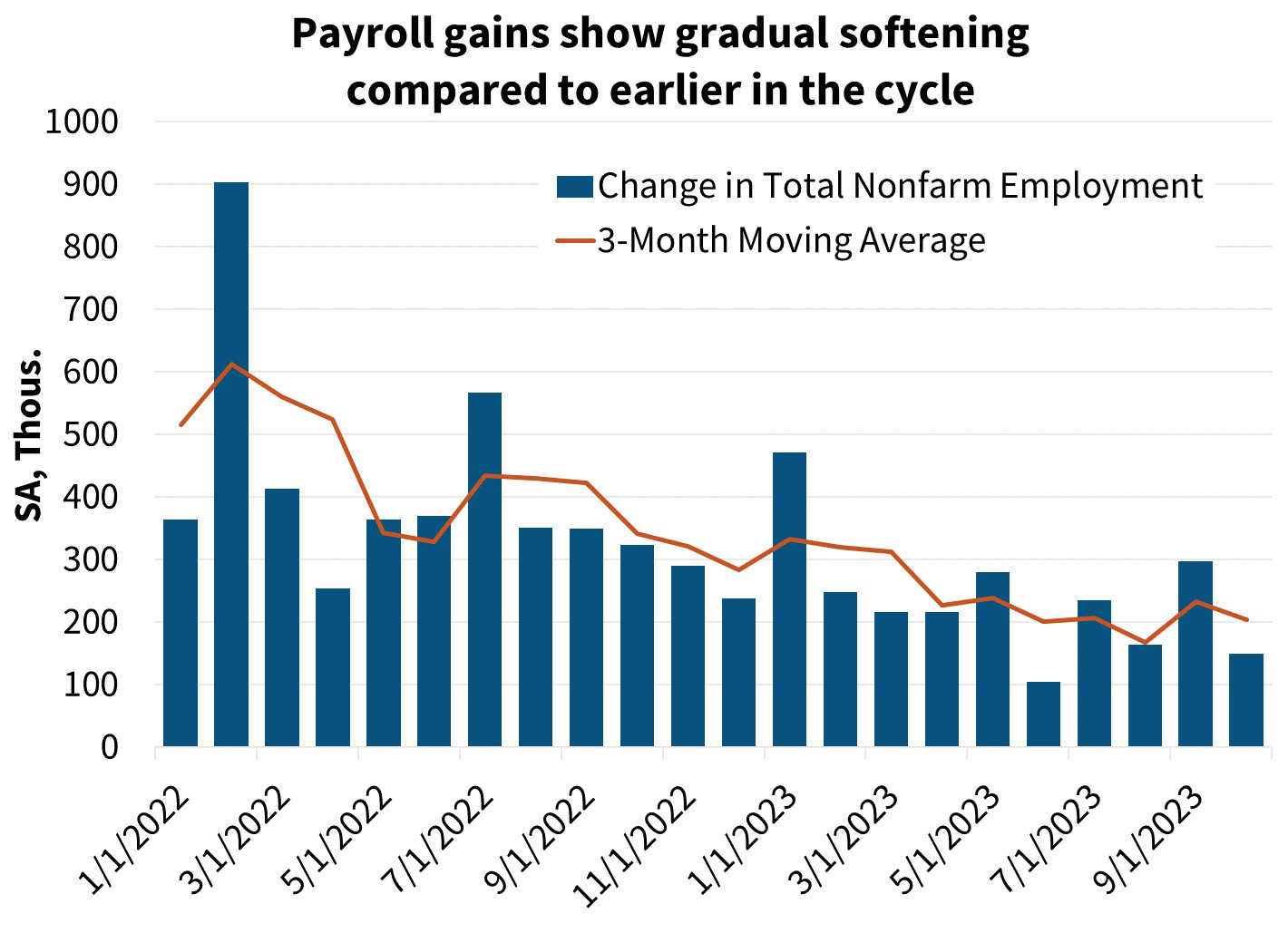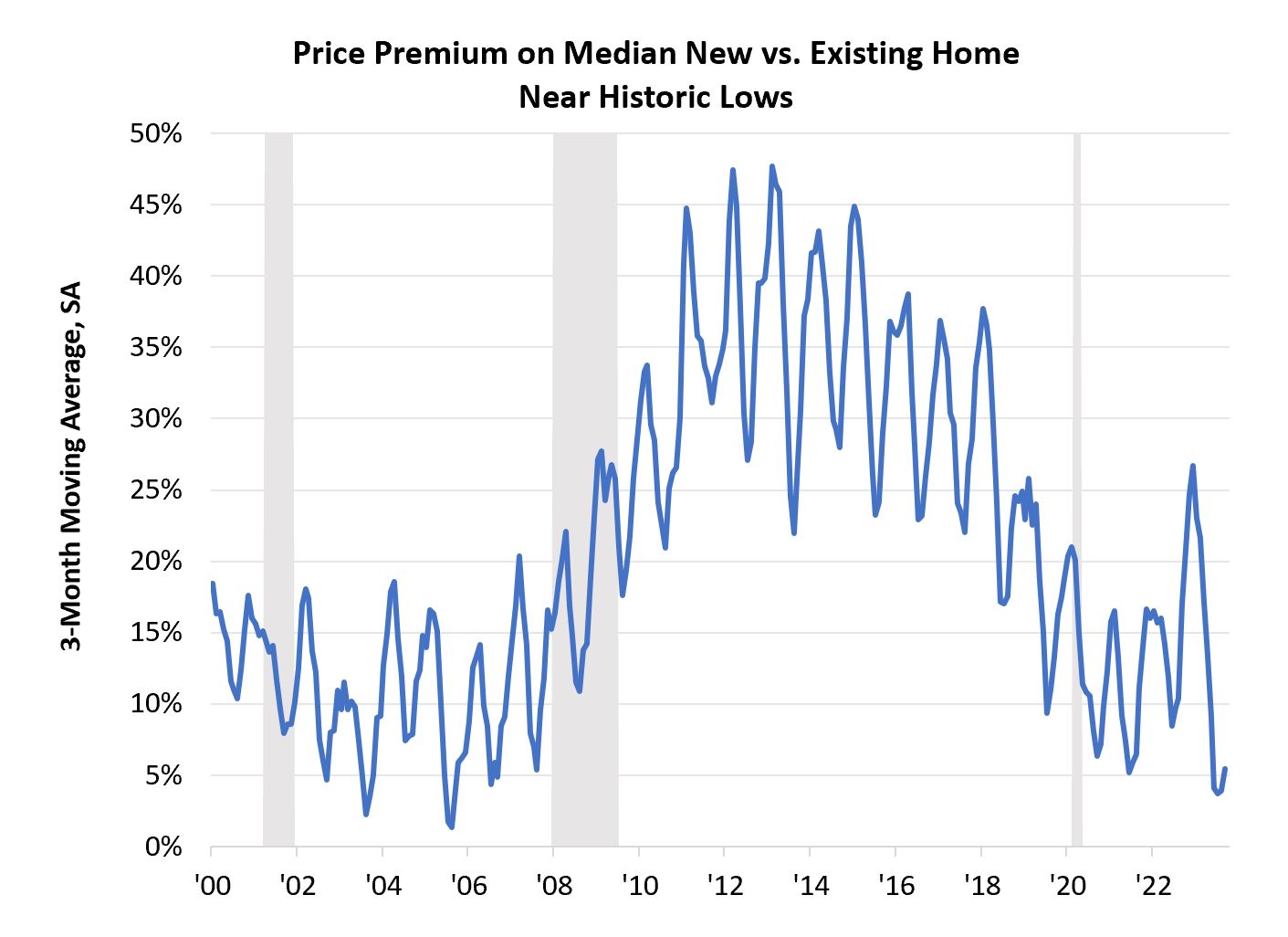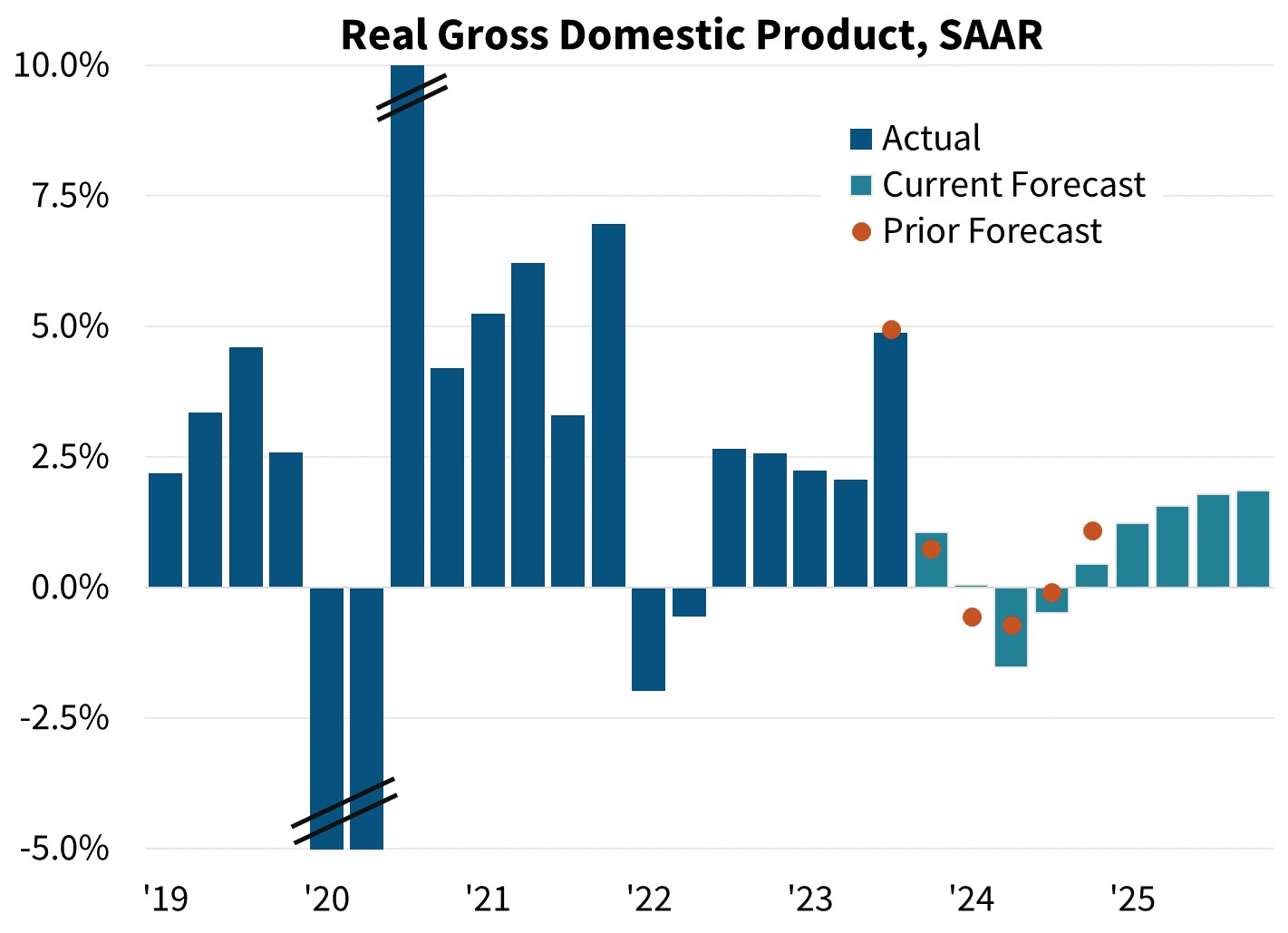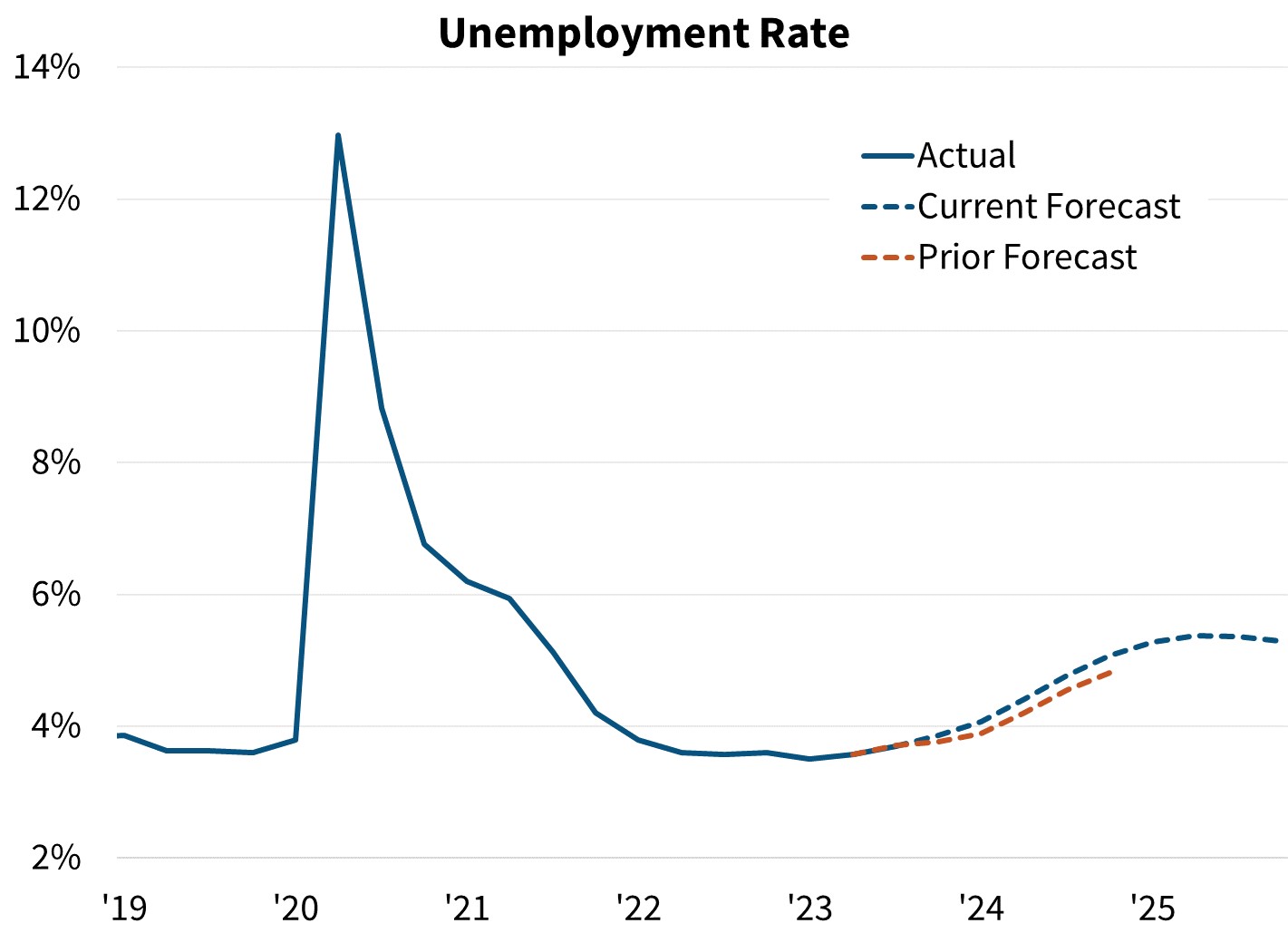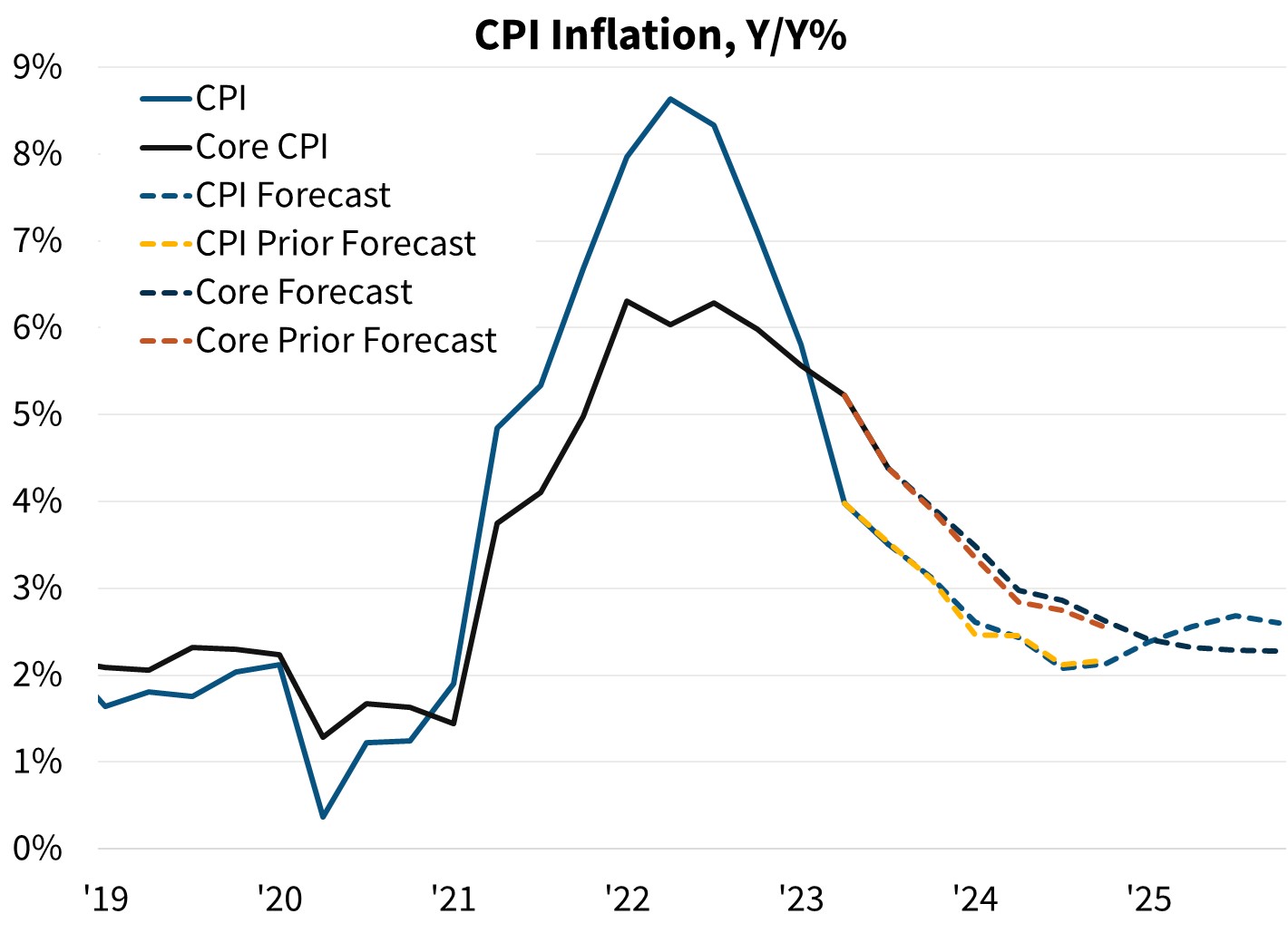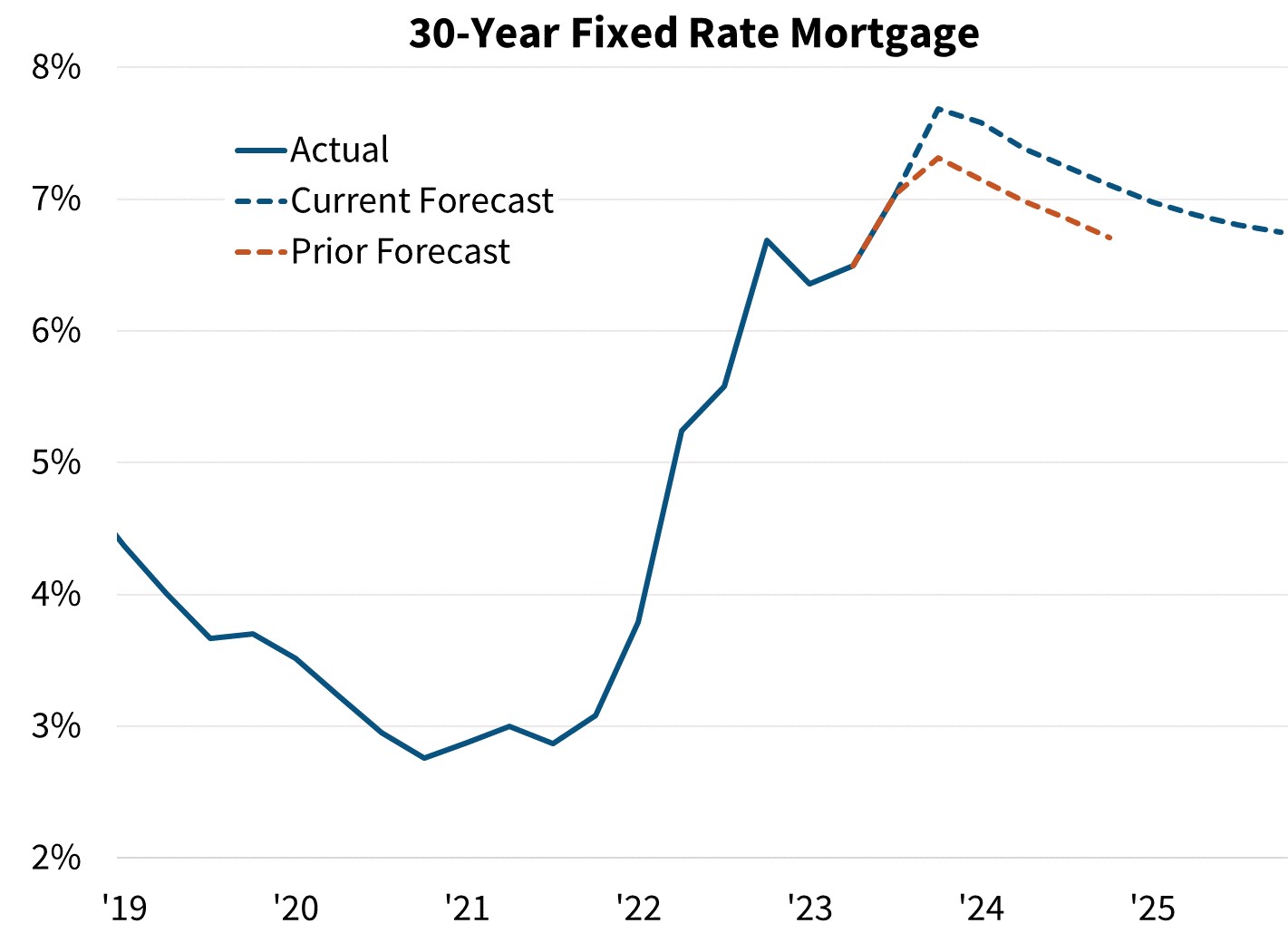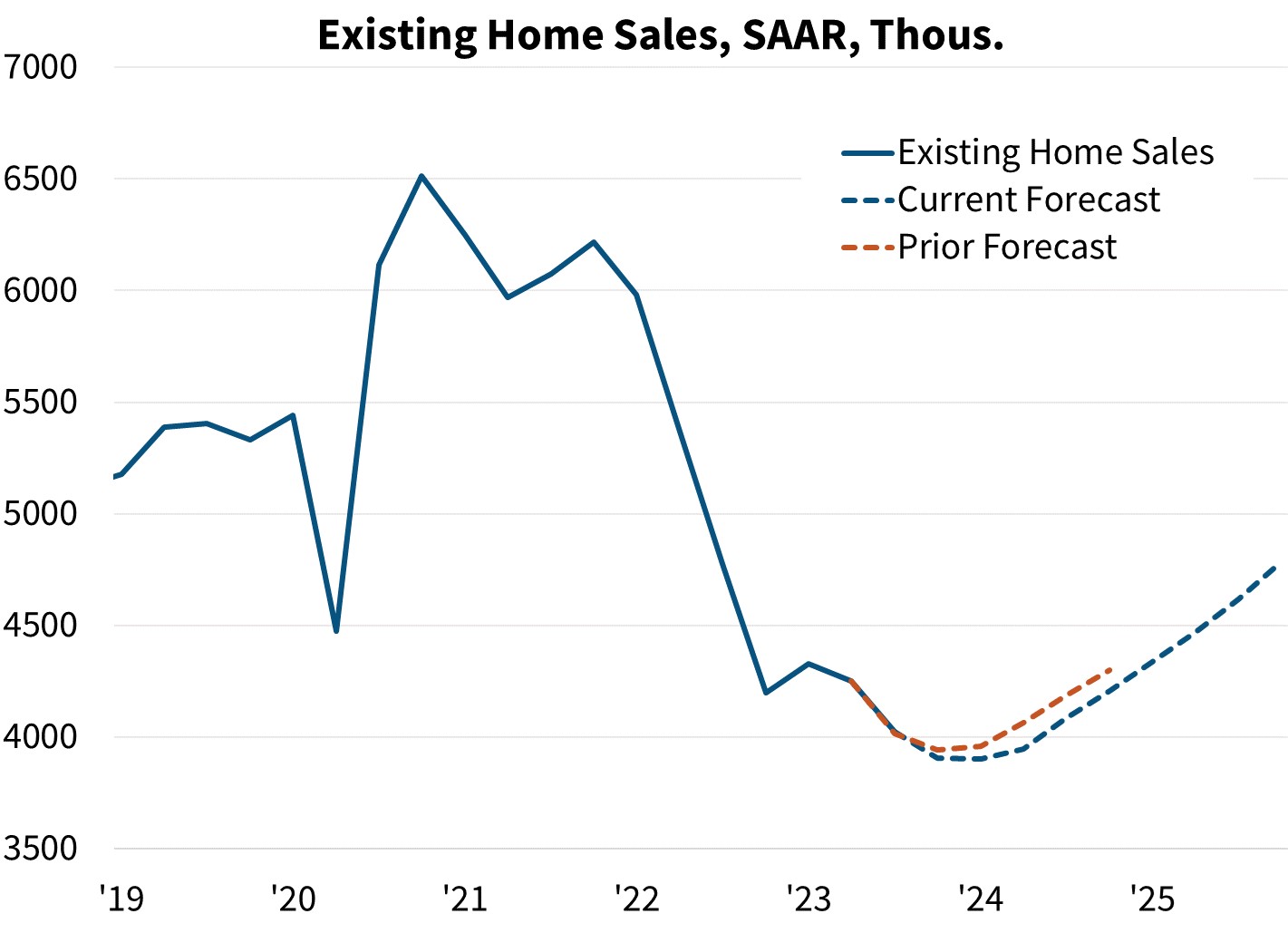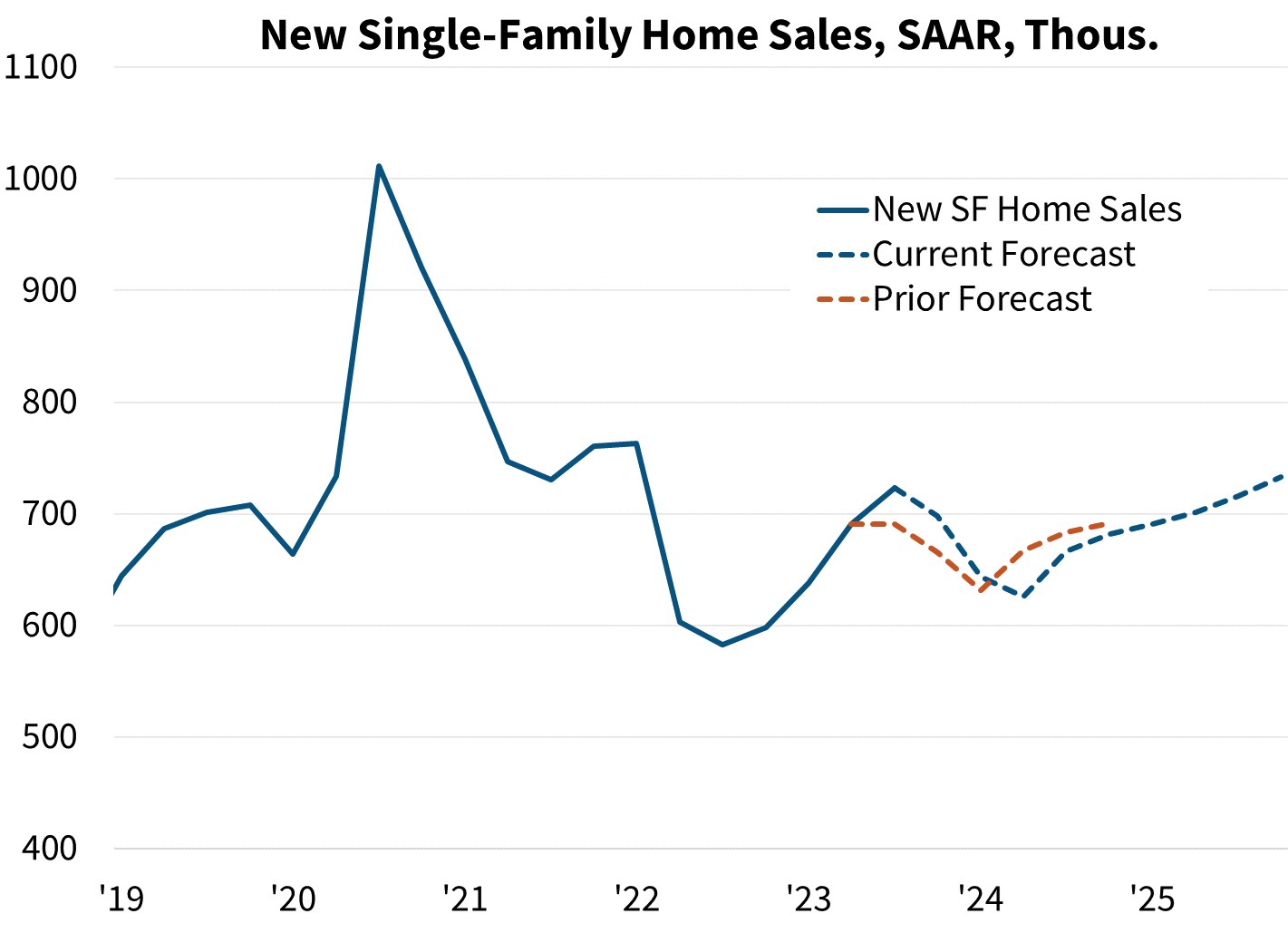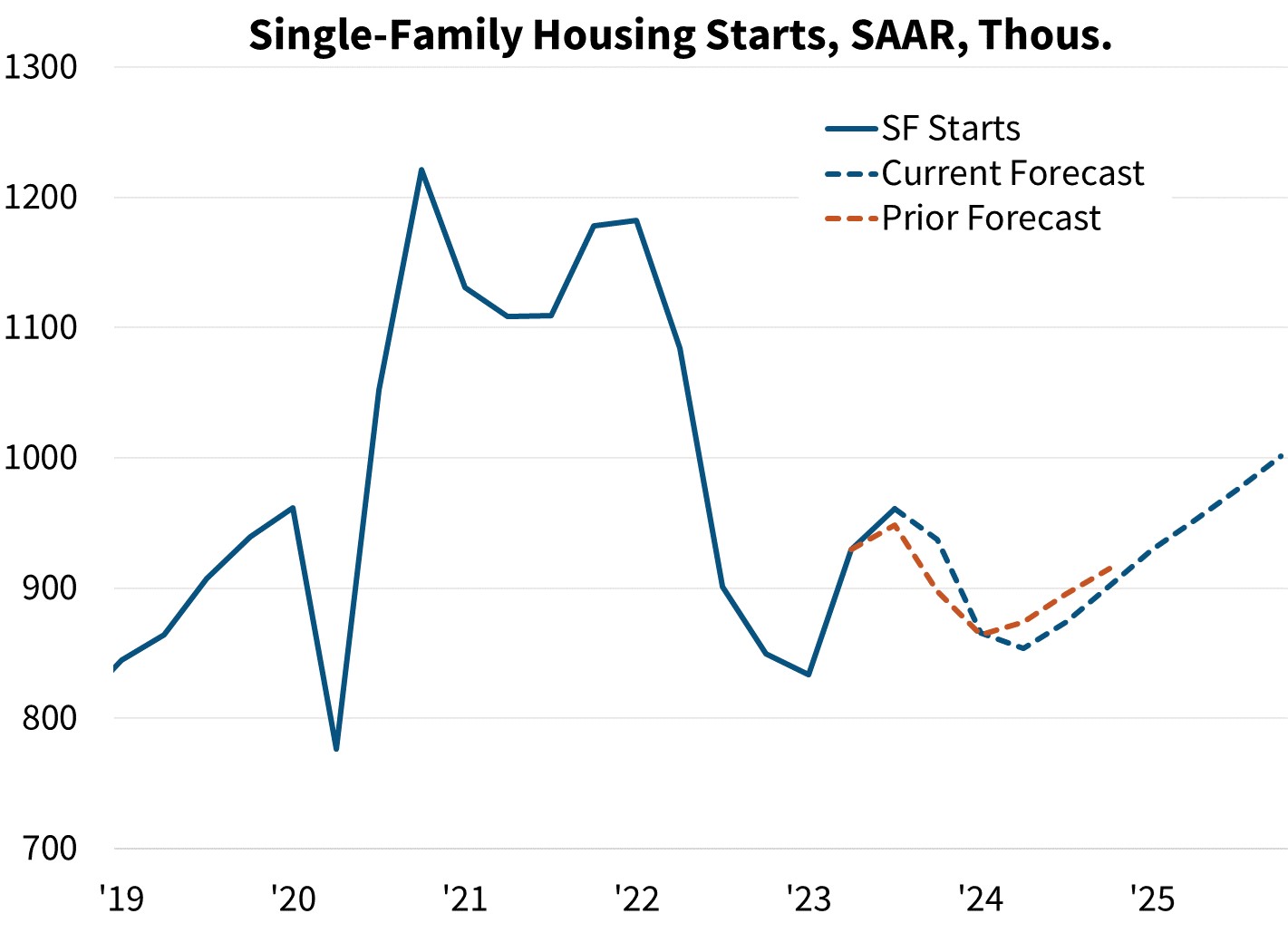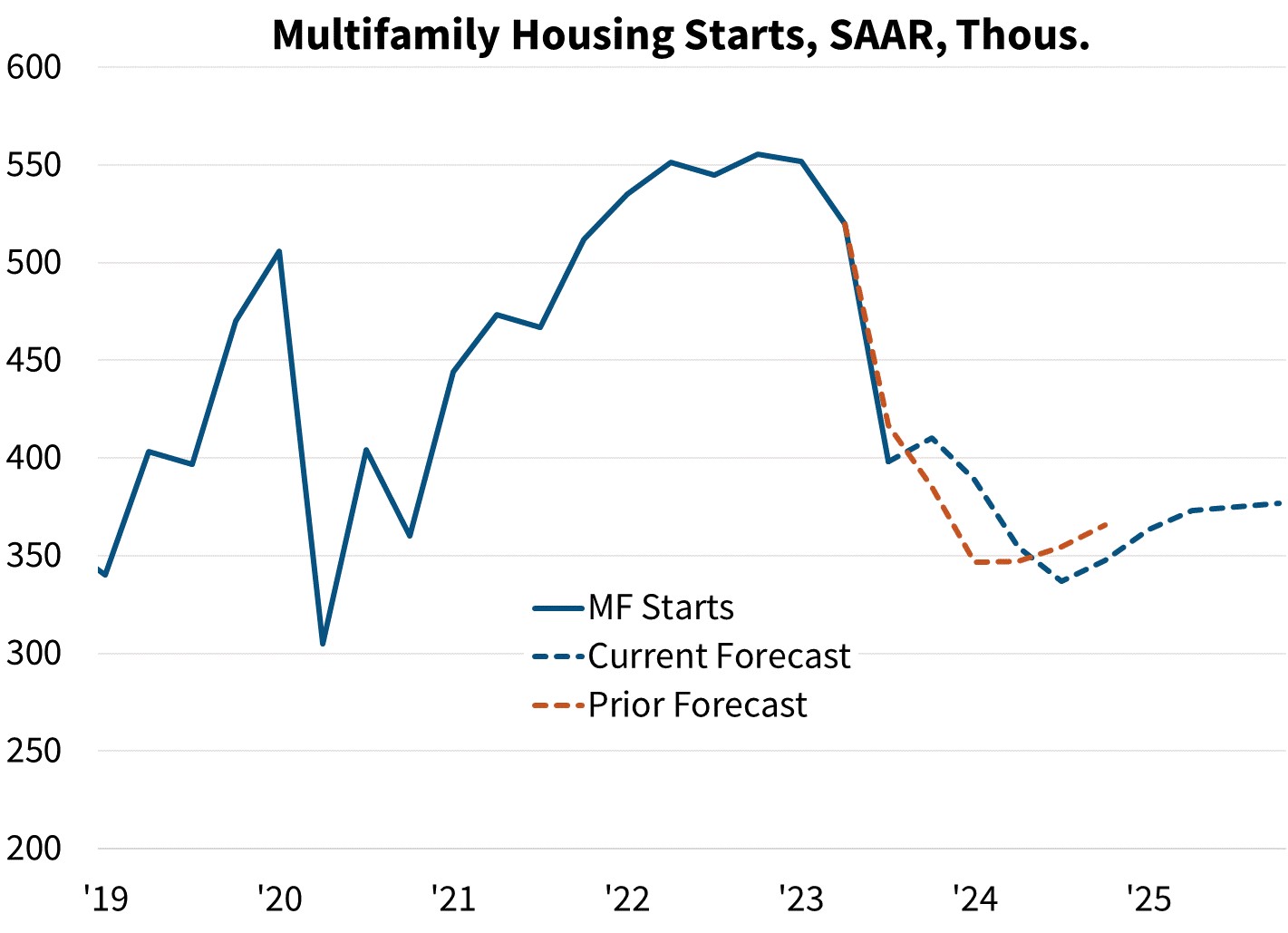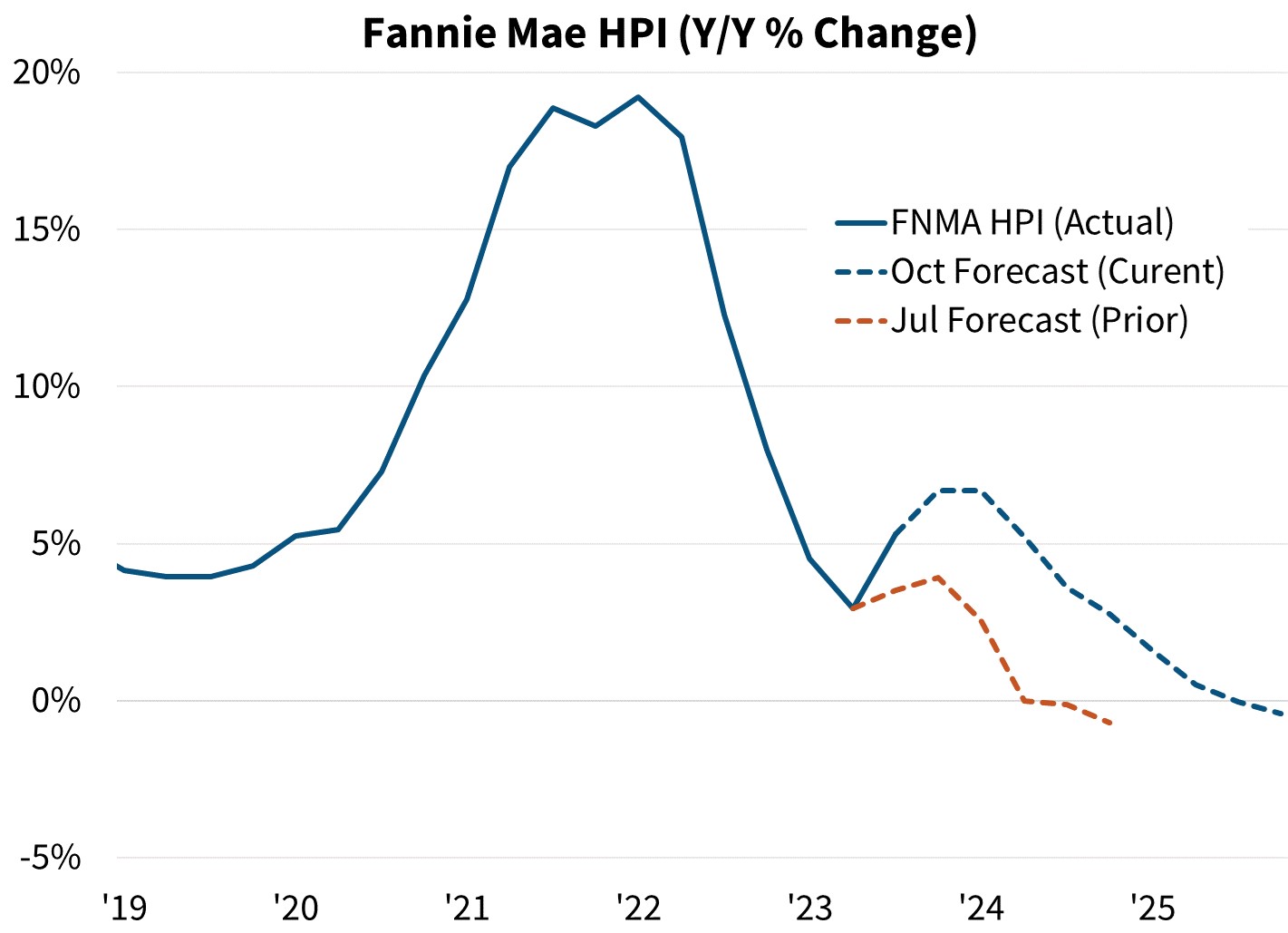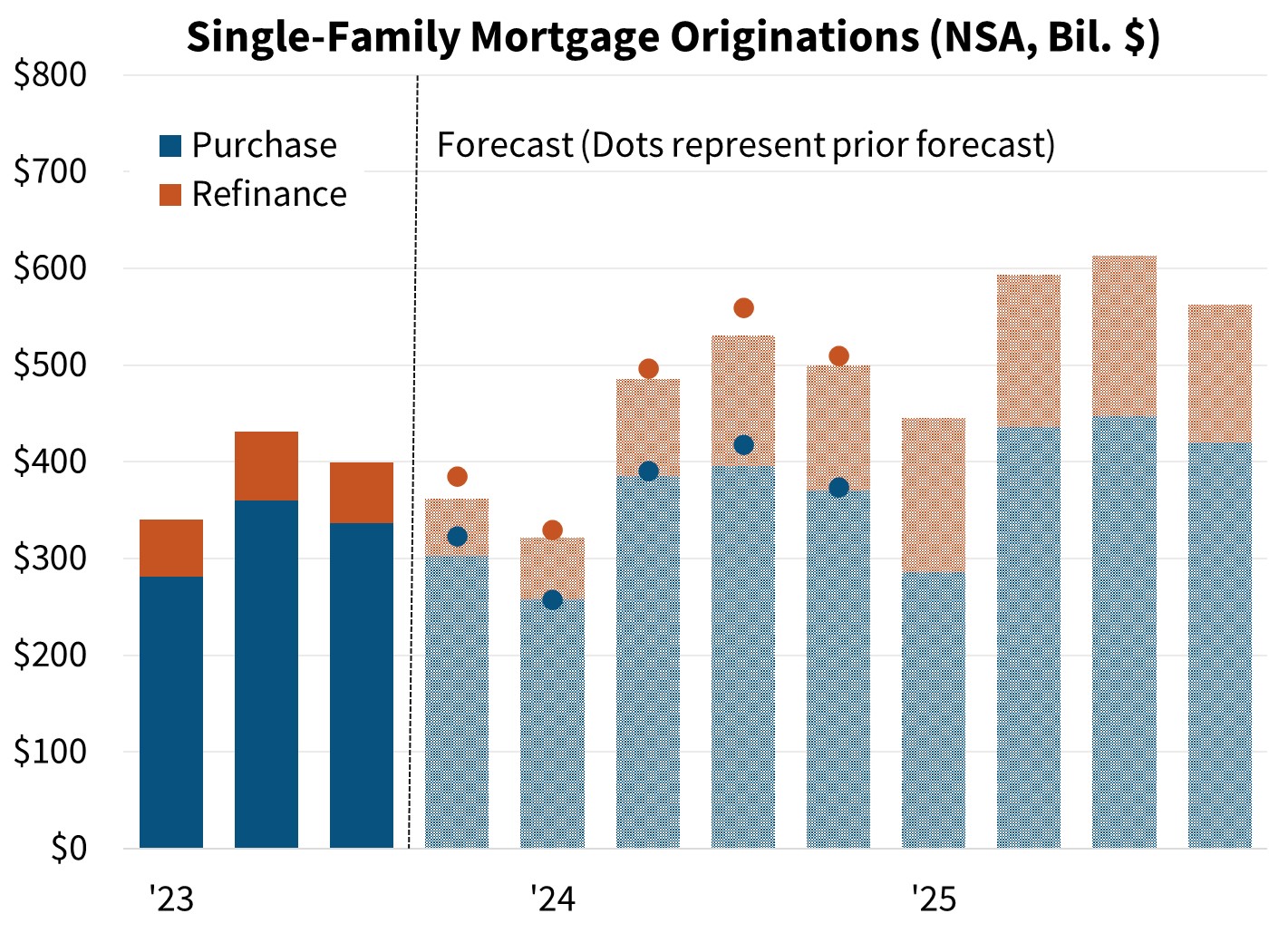Economic Developments - November 2023
For a PDF version of this report, click here.
With the November forecast we include one additional year to our outlook; in this case 2025. We remain in the camp of forecasters predicting a mild recession in 2024, with real gross domestic product (GDP) declining 0.4 percent on a Q4/Q4 basis. We anticipate that the recession will be brief and, for 2025 as a whole, we forecast the economy to expand by 1.6 percent. We expect the unemployment rate to peak at 5.4 percent in the middle of 2025, with core inflation trending toward the Federal Reserve’s 2-percent target.
We project home sales will likely bottom out in early 2024, regardless of a mild recession or a “soft landing,” as the peak drag from rising mortgage rates passes. We forecast mortgage rates to decline gradually over the next two years. When mortgage rates do ease, we expect sales will begin to rebound, albeit modestly due to the ongoing lock-in effect. The continuing lack of existing homes for sale will likely remain supportive of new construction. We forecast total home sales to be 4.8 million in 2023, essentially unchanged from our prior forecast, 4.7 million in 2024 (4.8 million previously), and 5.3 million in 2025. Combined with an increase in refinance volumes and some home price appreciation, we forecast total mortgage originations to grow from $1.5 trillion in 2023 to $1.8 trillion in 2024, and then to $2.2 trillion in 2025.
Q3 2023 Growth Was Strong, but a Slowdown Remains Likely
Real gross domestic product (GDP) surged to 4.9 percent annualized growth in the third quarter. However, despite the strong headline, the underlying details were less rosy. The strong 4.0 percent annualized jump in real personal consumption is likely to be unstainable given real personal incomes grew at only 0.6 percent annualized over the same period. The personal saving rate fell to 3.4 percent in September, well below its typical pre-pandemic level of roughly 7 percent. We expect consumption growth will moderate as spending and income return to a more historically normal relationship.
Business fixed investment (BFI), which is typically more indicative of business cycle contours, contracted at a 0.1 annualized rate in the third quarter. Moving forward, we expect higher real interest rates and tighter credit conditions to weigh on investment. For the three months ending in October, the Federal Reserve Senior Loan Officer Opinion Survey (SLOOS) showed that net lending standards for commercial and industrial lending, which typically leads measures of business credit outstanding in those categories, continued to tighten, albeit at a slower pace than before.
We project real GDP growth on a Q4/Q4 basis to be 2.6 percent in 2023 (2.5 percent previously), negative 0.4 percent in 2024 (negative 0.1 percent previously), and 1.6 percent in 2025. The change in the 2024 outlook largely reflects a shift in timing of the peak-to-trough GDP forecast aligning more with year-end dates, rather than a revised view of a deeper downturn.
Inflation and Labor Market Cooling
The labor market added 150,000 jobs in October and average hourly earnings rose just 0.2 percent over the month, indicating healthy but not overheated conditions. However, the unemployment rate ticked up to 3.9 percent, half a percentage point above its recent low in April, and both initial and continuing unemployment claims have trended upward. While recent data has been affected by the auto workers strike (which should reverse in the next data print), we think the labor market is now clearly showing a softening trend.
The October Consumer Price Index (CPI) report was also cool, with headline inflation flat over the month and core inflation increasing just 0.2 percent. From a year ago, headline and core prices increased 3.2 percent and 4.0 percent, respectively, each a slowdown from September. Furthermore, the CPI continues to be bolstered by time-lagged measures of rent, which will continue to fall based on more timely measures of market rents. Not including shelter, the CPI was up only 2 percent in October from a year ago. While the topline was dragged down in part by falling energy prices, we expect that annual core inflation will continue to move toward the Fed's 2-percent target over the next year.
Given the unemployment rate is still below 4 percent, a premature easing of monetary policy would risk reanimating inflation, so we do not expect the Fed to be quick in cutting rates in coming months. With slowing inflation, however, maintaining the current fed funds rate likely equates to increasing real short-term rates moving forward, putting further downward pressure on economic activity.
Near-Term Home Sales Poised to Slip Further Prior to Start of Rebound in Q4 2024
In response to mortgage rates approaching 8 percent this fall, mortgage application activity continues to trend downward, with purchase mortgage applications in October hitting the lowest level since 1995, according to the Mortgage Bankers Association. We are expecting Q4 seasonally adjusted existing home sales to be 3.90 million on an annualized basis, the lowest since Q3 2010.
However, although mortgage rates remain high, longer-run interest rates have pulled back significantly in recent weeks. While rates have been volatile, with markets weighing a stew of changing inflation expectations, heightened Treasury issuance and fiscal deficits, and global growth outlooks, the sharp drop in yields following soft October inflation print is noteworthy. It suggests once bond markets are convinced that inflation is contained, either via a soft landing or the start of a recession, that mortgage rates will have some room to recede, especially if the currently wide spread to the ten-year Treasury rate tightens after near-term worries of higher long-run Treasury yields soften.
We expect existing home sales to begin to rebound later in 2024 as mortgage rates pull back. While the lock-in effect and the low number of homes available for sale will likely persist for some time, these limiting factors will begin to diminish, and affordability will improve modestly on 30-year fixed mortgage rates below 7 percent. The recovery to a pre-pandemic level of sales will likely take years, but we forecast the bottom will be passed in 2024.
We expect some softening in single-family housing starts soon, as homebuilder confidence surveys have weakened in light of higher mortgage rates. However, if rates are to pull back even modestly, the mid-term outlook for new home sales and single-family housing starts will remain on solid footing. The lack of existing homes available for sale and what we believe to be a long-run deficit in the housing stock relative to demographic trends will support construction. A pullback in commodity prices, combined with many large homebuilders having locked in previous long-run financing at attractive rates, leaves many with sufficient operating margins to allow for continued concessions as needed to drive sales. Homebuilders continuing to push toward more modestly sized homes and in comparatively less expensive geographies has also kept new home sales prices historically low relative to the median existing home sales price. Combined with rate buydown concessions, a newly built home is now often comparatively affordable for many would-be homebuyers, and we expect this to be the case for the foreseeable future.
Economic Forecast Changes
Economic Growth
GDP grew at a 4.9 percent annualized rate in the third quarter of 2023. However, the underlying details were less robust. We continue to expect a slowdown over coming quarters as consumer spending growth has exceeded income growth and higher real interest rates weigh on business investment. Conceptually our forecast is little changed; however, we have shifted the primary quarters of our recession call back somewhat, with the peak negative quarter now expected in the second quarter of 2024.
Labor Market
Nonfarm payroll employment growth was 150,000 in October (though this was weighed down by about 30,000 due to the auto worker strike). The unemployment rate ticked up one-tenth to 3.9 percent, a half-percentage point above its recent low in April. Compared to last month, our forecasted unemployment rate was revised slightly higher due to incoming October data and a modest recalibration of the expected economic growth/labor market relationship.
Inflation & Monetary Policy
The October CPI report was generally in line with our expectations. Headline CPI was flat over the month and grew just 3.2 percent compared to a year ago. Core CPI rose 0.2 percent over the month, bringing the annual rate down to 4.0 percent. The report is broadly consistent with a continued cooling in inflation.
Our baseline expectation is that the Fed will not raise rates further this cycle but will keep policy tight until it is clear that inflationary pressures have abated.
Housing & Mortgage Forecast Changes
Mortgage Rates
Our interest rate forecast is higher this month, with the average FRM30 rate now predicted to average 7.7 percent over the fourth quarter of 2023. We expect the FRM30 rate to average 7.3 percent in 2024 and 6.9 percent in 2025. However, recent volatility at the long end of the yield curve adds additional risk to this forecast. As of this writing, the 10-year Treasury yield is nearly 50 basis points lower than the start of the month.
Existing Home Sales
Existing home sales were at a SAAR of 3.96 million in September, the first time the rate fell below 4 million since 2010. We have revised our forecast modestly downward largely due to the higher projected interest rate environment. Again, however, the heightened volatility of long-run interest rates in recent weeks points to risk around the sales projection.
New Home Sales
New single-family home sales jumped 12.3 percent to a SAAR of 759,000 in September, causing an upward revision to our near-term forecast. We have also revised the timing of our projected new home sales trough to align with the revised macroeconomic outlook. New home sales continue to benefit from the limited inventory of existing homes for sale and homebuilders' ability to buy down borrowers’ interest rates, improving relative affordability between the new and existing home markets.
Single-Family Housing Starts
Following the completion of our forecast, single-family housing starts rose to a SAAR of 970,000 in October and permits were at a pace of 968,000. While we continue to expect a softening trend in line with our forecast for a weakening economic backdrop, we have revised our forecast upward in the near term to reflect incoming data available as of the November 13 data release. We expect that the lack of existing homes available for sale will continue to boost new home construction in the medium term
Multifamily Housing Starts
Following the completion of our forecast, multifamily housing starts rose to a SAAR of 402,000 in October but were revised downward substantially in September. Permits rose slightly to a SAAR of 519,000. We have upgraded our near-term forecast to reflect incoming data but multifamily starts remain likely to decline as national rent growth has been muted and more multifamily units near completion.
Single-Family Home Prices
Home prices grew 5.6 percent compared to a year ago in August, according to the most recently published FHFA Purchase-Only House Price Index (HPI). Our Fannie Mae HPI home price forecast is updated quarterly and was last updated in October. Our next home price forecast update will be in January.
Single-Family Mortgage Originations
We have revised downward our forecast for purchase mortgage originations this month given downgrades to the home sales forecast. In particular, we now expect purchase volumes to be $1.3 trillion in 2023, a downgrade of $28 billion from last month’s forecast. We expect purchase volumes to rise in 2024 to $1.4 trillion as housing sales increase, a downgrade of $31 billion from the prior forecast and $1.6 trillion in 2025.
For refinances, we have kept our originations forecast essentially unchanged in 2023 at $252 billion and have decreased the forecast by $28 billion in 2024 to $428 billion. The decrease in 2024 is driven primarily by a higher mortgage rate forecast this month and limited refinance application activity, as illustrated by the Refinance Application-Level Index (RALI). Refinance originations are forecast to be $625 billion in 2025.
Economic & Strategic Research (ESR) Group
November 17, 2023
For a snapshot of macroeconomic and housing data between the monthly forecasts, please read ESR's Economic and Housing Weekly Notes.
Data sources for charts: Bureau of Economic Analysis, Bureau of Labor Statistics, Census Bureau, National Association of REALTORS, Freddie Mac, Fannie Mae
Opinions, analyses, estimates, forecasts and other views of Fannie Mae's Economic & Strategic Research (ESR) Group included in these materials should not be construed as indicating Fannie Mae's business prospects or expected results, are based on a number of assumptions, and are subject to change without notice. How this information affects Fannie Mae will depend on many factors. Although the ESR group bases its opinions, analyses, estimates, forecasts and other views on information it considers reliable, it does not guarantee that the information provided in these materials is accurate, current or suitable for any particular purpose. Changes in the assumptions or the information underlying these views could produce materially different results. The analyses, opinions, estimates, forecasts and other views published by the ESR group represent the views of that group as of the date indicated and do not necessarily represent the views of Fannie Mae or its management.
ESR Macroeconomic Forecast Team
- Doug Duncan, SVP and Chief Economist
- Mark Palim, VP and Deputy Chief Economist
- Eric Brescia, Economics Manager
- Nick Embrey, Economics Manager
- Nathaniel Drake, Economic Analyst
- Richard Goyette, Economic Analyst
